In the first lesson you learned how to work out the notes of any mixolydian mode by using its musical spelling. In this guitar lesson, we’re going to take a look at another useful way of looking at the mixolydian mode. (Like a lot of things in music, there are often multiple ways of approaching the same thing!).
So let’s get things rolling by talking about the important concept of relative major scales…
The Relative Major Scales Of The Mixolydian Mode
It’s incredibly important to understand that every mixolydian mode has a relative major scale that shares the exact same notes. Here’s an example of what I mean by this…
A Mixolydian Mode:

D Major Scale:

If you look very closely at the two scales above, then you might notice the following two things…
- The A Mixolydian mode is constructed from the same notes as the D Major scale. (Sure, the starting note of each scale might be different. But they’re still the same exact same collection of notes).
- Both of the scales have exactly the same key signature. (Two sharps).
Both of these facts mean that they are relative scales. Or put another way…
- The A Mixolydian mode is the relative mixolydian mode of the D Major scale.
- The D Major scale is the relative major scale of the A Mixolydian mode.
Why This Stuff Is Important
You might be wondering why understanding about relative major scales is important. I think that it’s a valid concern, because learning music theory without practical usefulness is just mental masturbation. 🙂
Probably the best way to illustrate the benefit of this theory is to ask you two quick questions…
- How many mixolydian scale fingerings do you currently know?
- How many major scale fingerings do you currently know?
If you’re like many guitarists, you probably know more major scale fingerings than mixolydian scale fingerings. (This is to be totally expected, because it makes sense to learn the major scale thoroughly before beginning to tackle the major scale modes!).
What this all means is that, by understanding about relative major scales, you can use all the major scale fingerings you know to solo in the mixolydian mode. For Example: If you wanted to solo over a backing track that’s in A Mixolydian, you could use all of the D Major scale fingerings that you currently know.
How cool is that? 🙂
How To Quickly Work Out The Relative Major Scales
Luckily, it’s not hard to work out the relative major scale of any mixolydian mode. All you need to do is work out the fourth note of whatever mixolydian mode you want to solo with. Let’s check out an example so that you can see what I mean…
D Mixolydian Mode:

If you look at the diagram above, you can see that the fourth note of the D Mixolydian mode is G. This mean that, if you wanted to solo in the D Mixolydian mode, you could use any G Major scale fingering that you know. (This is because the G Major scale is the relative major scale of D Mixolydian).
Rather than having to write out the notes of the mixolydian mode each time you want to work out the relative major scale, you could use this handy diagram instead…
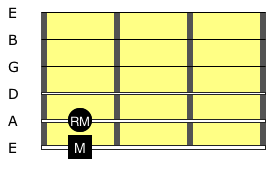
The fretboard diagram above gives you a really easy way of visualizing the relative major scale of any mixolydian mode. Here’s how to use it…
- Put your first finger on the root note of the mixolydian mode you want to solo with. (On the diagram, I’ve shown this using a square with an M on it). For Example: If you wanted to play a solo using the C Mixolydian mode, you would put your first finger on the 8th fret of the thick E-string).
- To find out what the relative major scale is, put your second finger on A-string, at the same fret as your first finger. (I’ve shown this on the fretboard diagram using the circle with RM on it). For Example: If we stay with the example of C Mixolydian, then your second finger will be on the note F on the A-string. This means that the relative major scale of C Mixolydian is F Major.
Work Out These Relative Major Scales
Now it’s time for you to work out some relative major scales for yourself. Using the visualization method that we’ve just talked about, please complete the following table…
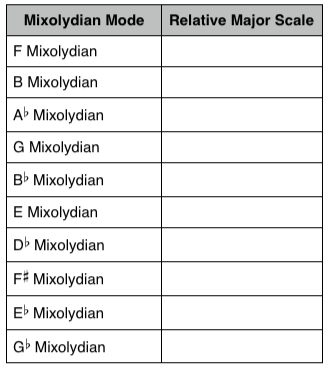
Because I’ll be giving you the answers at the end of the lesson, be sure that you complete this table before reading any further. Once you’ve done this, then you’re ready for the following practical application exercise…
Putting This Theory Into Practice
What we’re going to do now is look at an easy way of putting this theory into practice. Here’s what you need to do…
- Memorise the D Mixolydian chord progression shown below…
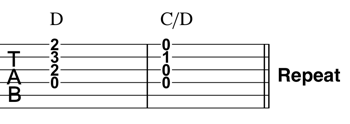
- Record yourself playing the chord progression for at least five minutes. Feel free to use any strumming pattern that you want.
- Over the chord progression you recorded in Step 2, improvise using the relative major scale. Because the progression is in D Mixolydian, this means you’ll be able to use any G Major scale fingering over it. Just in case you don’t know any fingerings for the G Major scale, I’ve included a really common one below…
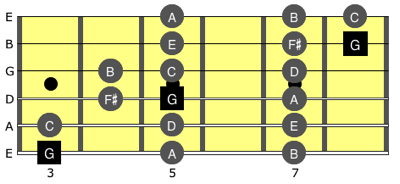
The Answers
Here is the answers for the relative major scales that you worked out earlier…
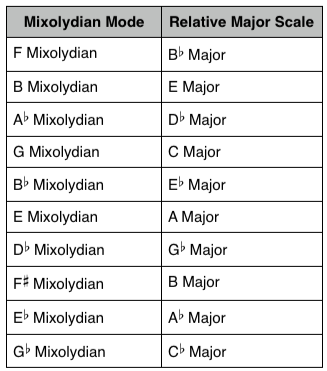
A Few Last Words
That’s all for this lesson. I hope you have enjoyed starting to delve into the mixolydian mode. It’s a great sounding scale, and I think you’ll find it an incredibly useful one to know. 🙂
Have fun!
Return To: Guitar Music Theory Lessons